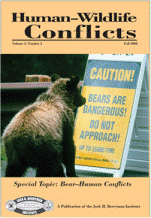Center, Internet, Wildlife Damage Management

Human–Wildlife Interactions
Date of this Version
Fall 2009
Document Type
Article
Abstract
Edwards Air Force Base (AFB) scheduled the construction of a runway in the spring of 2007. The runway would be in an area that contained migratory birds and their habitat. The construction project would be near Edwards AFB main runway and had the potential not only to impact species protected under the Migratory Bird Treaty Act (MBTA), including the burrowing owl (Athene cunicularia), but also to increase bird and wildlife–aircraft strike hazards in the active flightline areas. To discourage nesting in the project area, reduce the potential for bird and wildlife–aircraft strikes, and maintain compliance with federal environmental law, more than 400 potential nesting burrows and nesting habitat (e.g., trees, shrubs, and cacti) were removed prior to the nesting season and construction activities. The project footprint was routinely resurveyed to ensure migratory birds did not move back into the project area. As of May 31, 2007, approximately 890 ha were surveyed, compliance with the MBTA was maintained, bird–aircraft strikes did not increase, and the project schedule was not impacted. Removing migratory bird nesting habitat prior to the nesting season was instrumental in reducing the potential for bird and wildlife–aircraft strikes and maintaining compliance with federal law. This removal strategy can be employed in other large-scale construction projects.


Comments
Published in Human–Wildlife Conflicts 3(2):251–256, Fall 2009. Published by Jack H. Berryman Institute http://www.berrymaninstitute.org/journal/index.html